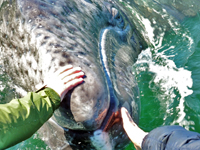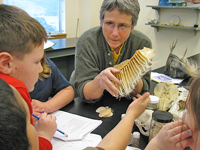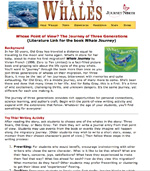| Please
Report Your Sightings! |
The cow/calf migration has begun and the first whales have reached Alaska! Kodiak 4th graders study whale food with scientist Anne Wynne, and biologist Wayne Perryman shares technology that helps "see" and count whales 24/7. Calculate how big the baby whales are now and study this photo for clues to why guides call this baby "Anaconda."
This Week's Report Includes:
- The Migration: News From Observation Posts
- Inquiry: Fourth Graders Investigate Whale Food
- Research: Learning from Whale Breath!
- Journal: How Big Are Those Babies Now?
- Activity: Breathe Like a Whale
- Tracking the Migration: Using Daily Data
- Literature Link: Whale Journey

Photo: Patrycja Kaczynska
Why
did lagoon guides call this whale baby "Anaconda"?
|
Alaska, here they come! The first gray whales at Kodiak, Alaska (#16) were reported March 24! And here come the moms and calves! Counter Point (#7, see photo) reported Numero uno — their first calf of 2010, on March 25. First cow/calf pairs were also reported at San Diego (#5) and even as far north as Washington state. A gray whale surprised West Seattle whale-watchers on March 27 and it was a peak week along the Oregon coast, with Whale Watching Spoken Here (#12 ) reporting 70 whales on one day! Fog and wind hampered a few days of the past two weeks, but volunteers at both our California point-count sites reported their highest numbers yet, with a few calves among them. Meanwhile in the lagoons of Mexico, guide Keith Jones shows us the official census document from Laguna Ojo de Liebre (#3). See it yourself and give thought to Keith's question. At San Ignacio Lagoon (#2) guide Patrycja shares her last report and photos before she migrated north herself. She introduces us to Anaconda and El Machete, and shares her ideas why mom/calf numbers are so low. Wayne Perryman wonders that too, as he begins his annual cow/calf census at Pt. Piedras Blancas, CA (#8). |
|
Visit Maps for the latest First Northbound and First Cow/Calf Pair maps and sightings! |
As
gray whales headed north past their town, teacher Judith Phillips and
her 4th graders from Kodiak Elementary School in
Alaska had a day of hands-on science this week. "A local scientist,
Switgard Duesteloh, has set up an Ocean
Science
Discovery
Lab
for the school
district," explains Ms. Phillips. "The lab is
in
the
Fisheries
Tech
Center
(NOAA). Standards-based lessons are offered for each grade
level; fourth graders study the food chain."
Here's a look:
 |
||
Scientist Kate Wynne works with students at a station called "What Whales Eat." She demonstrates feeding methods. (Do you see the baleen?) Students examine vials with actual whale stomach contents. They also look at zooplankton through microscopes. What questions would YOU like to explore about what whales eat, how they eat, how much they eat, how babies learn to eat, how whales can go several months without eating much during migration — or any other questions you wonder about whales? Send your questions to Ask the Expert, open April 2! |
||
You know that whale observers look for whale spouts, or blows, to find the whales. But fog, rain and darkness can make whales and their misty spouts impossible to see. On this year's southbound migration, biologist Wayne Perryman and his crew tested some new equipment that lets them "see" whales despite conditions on the water. A special camera "sees," or detects and measures, even the tiniest amounts of heat (infrared radiation) given off by objects, such as the warm spout of a whale. It captures the heat as an image and sends it to a computer screen. Here's what the scientist sees:

Photo Adrienne DeLiso
A whale's spout, or exhale blow, is warmer than the air around it.
These computer screen images show three different things that passed the infrared camera: a fishing vessel, a whale blow, and a passing jet plane. Which do you think is shown in each image? TIP: The hotter the object, the whiter the image. Think, then click a photo to see if your prediction is correct. Discoveries lead to new questions. What are YOUR questions? Would you like to hear more about how thermography works? What do whale scientists hope to learn with it? Our interview with Wayne Perryman and his co-workers offer questions and answers. And we invite you to send your own questions to Ask the Gray Whale Expert, open April 2! |
||
At birth, gray whale calves (babies) are about 15 feet long and weigh 1,500 pounds. These fast-growing babies may gain 70 pounds a day on a diet of 50 gallons of rich milk (53% butterfat!) from their mothers.
- How much would a baby weigh today if it was born December 31? Why is it important for whale babies to grow so fast? Why aren't humans designed to grow that fast?
- Do you have questions for Ask the Expert?

Did you know that a migrating gray whale has a predictable breathing pattern? The whale generally exhales, or blows, 3-5 times in 15-30 second intervals. Then it raises its fluke (tail) in a dive and submerges for 3-5 minutes.
Try This: Ask a partner to watch the clock while you pantomime this sequence of events to get a feel for the whales’ pattern of inhaling, holding its breath and diving, then surfacing to exhale and take another breath.
 Photo:
Michael H. Smith
Photo:
Michael H. Smith
A gray whale can stay submerged up
to 15 minutes. (Don't try that!)
Review: The pulses generally move up the coast in this order: (1) newly pregnant females, (2) males, juveniles from the previous year and non-pregnant females, (3) cow/calf pairs. Data collected at our two California point count stations can help you see this pattern.
Has the migration peaked? Do you think another phase of the migration has begun? What do the data show?
- What is the main thing you notice about the recent numbers of whales at both Coal Oil Point and Los Angeles?
- What was the largest day for sightings at each of our California point-count sites?
- What changes do you predict you'll see when your next data comes in two weeks?
- Graphing gray whale data through the whole season at one or both California posts? Add the latest data.
| Fun To Know: For the ACS/LA, this year's first northbound cow/calf sighting was March 16; last year it was March 28. For watchers at the Gray Whales Count site, this year's first cow/calf sighting was March 25; last year's was March 30. |
In her 50 years, Old Gray swam a distance equal to traveling to the moon and home again. What's in store for her baby, about to make his first migration? Check your library or online for Whale Journey by Vivian French (1998, Zero to Ten Limited). This richly detailed picture book is for all ages. Join three generations of whales on their travels. After reading this gripping story, enjoy a point-of-view writing experience (or choose other fun activities) built on this literature link to the study of gray whales in
Open April 2-16, 2010
- Overview: Tracking Gray Whale Migration from California Observation Posts
- Image of the Week: Why did lagoon guides call this whale baby "Anaconda"?
- Adaptations: More About Baleen
- Interview: Using Thermography to Study Whales
- Reading Strategy: Paraphrase/Retell
- Literature
Link: Whale Journey

- Using Data: Questions About This Week's Data

Meet
Kim Shelden,
Gray Whale Expert
The Next Gray Whale Migration Update Will Be Posted on April 14, 2010.











